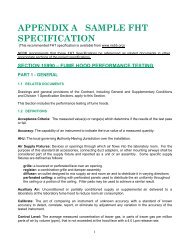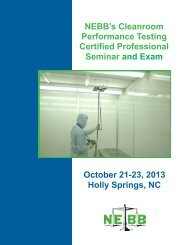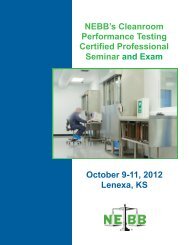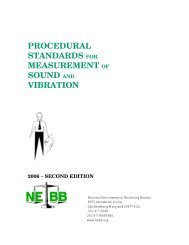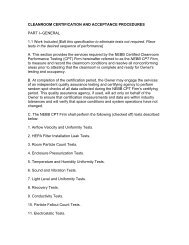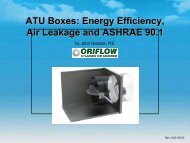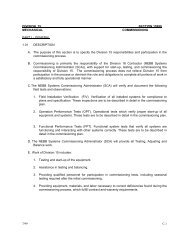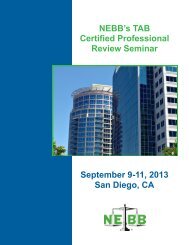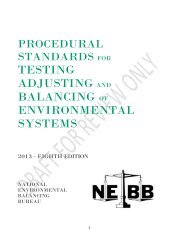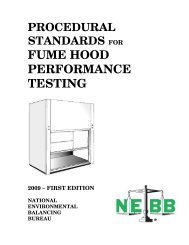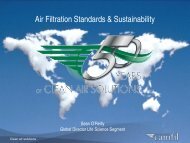Top Ten Reasons Building HVAC Systems Do Not Perform ... - NEBB
Top Ten Reasons Building HVAC Systems Do Not Perform ... - NEBB
Top Ten Reasons Building HVAC Systems Do Not Perform ... - NEBB
You also want an ePaper? Increase the reach of your titles
YUMPU automatically turns print PDFs into web optimized ePapers that Google loves.
<strong>Top</strong> <strong>Ten</strong> <strong>Reasons</strong> <strong>Building</strong> <strong>HVAC</strong><br />
<strong>Systems</strong> <strong>Do</strong> <strong>Not</strong> <strong>Perform</strong> as Intended<br />
Health Care Facilities Measuring<br />
Isolation Room Pressure—<br />
What <strong>Do</strong> the CDC Guidelines Say?<br />
Creating Audible Sound from Sloppy<br />
Pump Motor Replacement<br />
Designing for Proper Testing,<br />
Adjusting & Balancing of Air<br />
& Hydronic <strong>Systems</strong><br />
RECENT <strong>NEBB</strong> HIGHLIGHTS<br />
The <strong>NEBB</strong> Professional – July 2012<br />
The official magazine of the<br />
National Environmental Balancing Bureau<br />
July 2012<br />
i
ii<br />
Real-Time Solutions for <strong>HVAC</strong> Professionals<br />
The full line of TSI and Alnor industrial ventilation test instruments are<br />
designed to accurately and reliably measure a wide variety of parameters<br />
important in monitoring and maintaining indoor environments.<br />
Feature-Rich, Velocicalc ® 9565<br />
Multi-Function Ventilation Meters<br />
• Accommodates a variety of plug-in probes<br />
• Displays up to five measurements simultaneously<br />
• On-screen messages and instructions<br />
• Multiple data logging formats<br />
• Bluetooth communications for transferring data<br />
or remote polling<br />
Request a Free <strong>HVAC</strong> Assessment Handbook<br />
at www.tsi.com/hvac_handbook<br />
TSI Incorporated<br />
Tel: 1 800 874 2811 Web: www.tsi.com/vti<br />
Industry-Leading Alnor ®<br />
EBT721 Capture Hood<br />
• Ergonomic design and ultra light weight for easy one<br />
person operation<br />
• Detachable digital manometer for use in<br />
other applications<br />
• Use with pitot, air flow, temperature, or relative<br />
humidity probes<br />
• Data logging for easy report generation<br />
Highly Accurate pAn200 Series<br />
Duct Leakage Testers<br />
• positive and negative Duct Leakage Testing<br />
in one system<br />
• Generates a pass/Fail result based on SMACnA’s duct<br />
leakage test manual<br />
• High accuracy gives confidence in measurements<br />
• pressurizes duct quickly, allowing testing to begin<br />
in minutes<br />
• Includes TSI Velocicalc ® Model 9565-P and<br />
Dp-calc 5825
The <strong>NEBB</strong> Professional – July 2012<br />
Letter from the <strong>NEBB</strong> President<br />
One of the greatest pleasures in running a successful organization like <strong>NEBB</strong> is serving people who are part of the <strong>NEBB</strong><br />
community. Our members have a reputation for assisting building owners, architects and contractors in producing and<br />
maintaining buildings with systems that perform as they were visualized and designed. This reputation is a result of our<br />
strict adherence to <strong>NEBB</strong> Procedural Standards supported year round by training seminars, publications and <strong>NEBB</strong>’s<br />
Quality Assurance Program.<br />
I was fortunate to meet many <strong>NEBB</strong> professionals at the 2012 <strong>NEBB</strong> Annual Conference in Anaheim, California. I am<br />
deeply touched by their excitement and resolve to continue to deliver exceptional service to meet the sustainability<br />
goals set by industry.<br />
As someone with more than 30 years of experience in the <strong>HVAC</strong> industry, my goal is to promote further knowledge<br />
and performance of our professionals in this growing marketplace. There is a lot of focus on sustainability issues that<br />
are addressed by each of <strong>NEBB</strong>’s eight disciplines as they help meet sustainability goals of building systems. There is<br />
growing awareness and acceptance of <strong>NEBB</strong>’s procedural standards as the leading source in the industry not only in<br />
the United States but also around the world. We continue our quest to lead the industry in developing the best standards<br />
designed to optimize building systems performance through ongoing feedback and support of our customers.<br />
In the United States, the Federal government mandated that all federal facilities reduce energy consumption by 30%<br />
by 2020. Several agencies, Air Force, Veterans Hospitals, Navy and the Air National Guard, have already implemented<br />
retro-commissioning (RCx) projects to meet these requirements. These agencies have specified the use of <strong>NEBB</strong>’s<br />
Retro-Commissioning Procedural Standards. The <strong>NEBB</strong> RCx Certified Firm enjoys a natural head start.<br />
The <strong>NEBB</strong> BSC Committee appointed task forces to upgrade the Procedural Standards to make them clearer and<br />
accentuate the technical competency possessed by <strong>NEBB</strong> BSC and RCx Certified Firms.<br />
These <strong>NEBB</strong> disciplines could provide another source of income to the <strong>NEBB</strong> Certified Firm and Certified Professional<br />
willing to make any changes necessary to become additionally certified. Watch for these new Procedural Standards to<br />
be published this summer.<br />
Neil Marshall<br />
President<br />
Index of Articles<br />
• <strong>Top</strong> <strong>Ten</strong> <strong>Reasons</strong> <strong>Building</strong> <strong>HVAC</strong> <strong>Systems</strong> <strong>Do</strong> <strong>Not</strong> <strong>Perform</strong> as Intended 2<br />
• Health Care Facilities Measuring Isolation Room Pressure—What <strong>Do</strong> the CDC Guidelines Say? 7<br />
• Creating Audible Sound from Sloppy Pump Motor Replacement 11<br />
• Designing for Proper Testing, Adjusting & Balancing of Air & Hydronic <strong>Systems</strong> 14<br />
• Recent <strong>NEBB</strong> Highlights 19<br />
The <strong>NEBB</strong> Professional is a quarterly magazine published by the National Environmental Balancing Bureau.<br />
Mandy Kaur, Editor | 8575 Grovemont Circle, Gaithersburg, MD 20877 | Tel: 301.977.3698 | Email: marketing@nebb.org<br />
1
2<br />
<strong>Top</strong> <strong>Ten</strong> <strong>Reasons</strong> <strong>Building</strong> <strong>HVAC</strong> <strong>Systems</strong><br />
<strong>Do</strong> <strong>Not</strong> <strong>Perform</strong> as Intended<br />
Dave McFarlane, Chairman | <strong>NEBB</strong>’s Retro Commissioning Committee<br />
The Heating, Ventilating and Air Conditioning<br />
Contractor (<strong>HVAC</strong>) and the Sheet Metal Journeyman’s<br />
roles in the construction of new and existing building<br />
projects can play a major part in the final comfort<br />
and energy efficiency of a building. There appear to<br />
be many issues prevalent in the <strong>HVAC</strong> industry that<br />
directly affect energy usage, sound and comfort levels<br />
in buildings.<br />
This article will show several problem areas our firm<br />
finds recurring on projects. It is always easier to correct<br />
problems before the problems are built into the system.<br />
The knowledgeable contractor who understands the<br />
applicable standards will install these items per the<br />
proper standards or notify the engineer before performing<br />
work that could create a potential problem. This will<br />
reduce problems and reduce chances for an adversarial<br />
relationship to develop between the design engineer and<br />
the contractor once the project is completed.<br />
Issue # 1<br />
Ductwork is not reinforced for the proper SMACNA<br />
pressure classifications.<br />
The Sheet Metal and Air Conditioning Contractors<br />
National Association (SMACNA) is the association<br />
that has published duct construction standards<br />
that designate the proper way to fabricate and<br />
install ductwork, duct accessories and air handling<br />
equipment. These standards are so prevalent that most<br />
construction documents and specification say to the<br />
effect “Install ductwork to SMACNA standards”.<br />
However, it is the very familiarity with the term SMACNA<br />
standards that has led engineers, contractors and sheet<br />
metal journeymen to forget to examine current SMACNA<br />
documents. These standards have been continually<br />
upgraded and improved over the years. The current<br />
SMACNA standard is the 3 rd edition dated 2005. We still<br />
find many engineers and contractors specifying and<br />
installing ductwork exactly like they did 25 years ago.<br />
SMACNA pressure classifications now specify<br />
ductwork reinforcing for specific duct pressures from<br />
½ inch to 10 inches of static pressure. It is the design<br />
engineer’s responsibility to specify the systems<br />
design static pressure. If the design engineer does not<br />
specify an exact static pressure, but instead states<br />
“Install ductwork to SMACNA standards”, SMACNA<br />
standards compliance will have ductwork built to a<br />
1 inch pressure class, with the exception of ductwork<br />
upstream of a VAV box which should be constructed<br />
to 2 inch pressure.<br />
This lack of clarification by the design professional<br />
or failure of the installing contractor to follow the<br />
required pressure classifications shown in the<br />
specifications is the main reason ductwork collapses<br />
or blows apart. The duct failure is invariably due to the<br />
fact that the proper pressure class was not specified<br />
or the ductwork was not constructed to the proper<br />
pressure classification. It is relatively inexpensive<br />
insurance for the installing contractor to check the<br />
pressure classification to verify that a reasonable<br />
pressure has been specified for the ductwork and that<br />
the actual current SMACNA pressure classifications<br />
are being followed in the field.<br />
Figure 1. Collapsed ductwork hanger rod inadequate<br />
reinforcement
Figure 2. Ductwork blown out and bending<br />
Issue # 2<br />
Failure to adequately seal ducts.<br />
Duct leakage refers to the fact that air inside a supply<br />
duct under positive pressure will leak out of the<br />
Pittsburg or Snap lock seams, from the slip, drive or<br />
TDC connector joints or out of wall penetrations from<br />
damper rods, screws used in hanging ducts or any<br />
other wall penetrations.<br />
This leakage causes two problems. When air leaks out<br />
of a duct system, some areas at the end of the run<br />
may be short of airflow because the air has leaked from<br />
the system before it reaches its intended location. This<br />
lack of air can cause over heating in the summer or the<br />
inability to heat in the winter.<br />
In some cases the fan has the ability to supply enough<br />
air to overcome the leakage rate and still meet the<br />
room requirements. Excessive fan energy is used to<br />
provide the required flow to spaces. The fan energy<br />
increases as the cube of the air leakage. For example<br />
if a system has 10% leakage and the fan design was<br />
originally 20 Horsepower (HP), the new motor required<br />
to overcome the 10% loss will be 20 HP x (1.1) 3 = 26.6<br />
HP. In this case, the owner pays for an additional 6.6 HP<br />
fan operation for the life of the building.<br />
SMACNA has specified the duct sealing requirements<br />
for duct systems. If ductwork is not sealed, leakage<br />
rates of 25% on 2 inch plus ductwork can be expected.<br />
SMACNA seal classes of Seal Class A, B and C define the<br />
degree of sealing required to be completed. Seal Class<br />
The <strong>NEBB</strong> Professional – July 2012<br />
C means that all Transverse joints (Slip, Drive, and TDC)<br />
connections need to be sealed. Seal Class B means that<br />
all longitudinal seams (Pittsburg and Snap lock) and<br />
all joints as above need to be sealed. Seal Class A is<br />
the most stringent and means that all wall penetration<br />
(damper rods, screws and duct accessories) must be<br />
sealed in addition to all seams and joints as defined<br />
above.<br />
Failure to properly specify sealing or to actually seal<br />
ducts in the field are the primary reasons ductwork<br />
systems leak.<br />
Issue # 3<br />
Failure to understand the need to seal return and<br />
exhaust ducts.<br />
Air will leak into the ductwork through the same<br />
openings described above. When excessive leakage<br />
occurs in exhaust ducts, it is sometimes impossible to<br />
obtain the required exhaust air at the needed location.<br />
We encounter many cases where the exhaust air flow<br />
at the fan is 15% over design and the exhaust flow at<br />
the register or hood location is 20% under design. This<br />
discrepancy is due to the fact that air is leaking into<br />
the duct systems along the duct route and not at the<br />
specified exhaust point. This can lead to stuffy, stagnant<br />
rooms or laboratory exhaust systems not performing as<br />
required. System operating costs are also increased by<br />
the amount as calculated in Item 2 above.<br />
Issue # 4<br />
Failure to adequately pressure test ductwork to<br />
prove that duct sealing is effective.<br />
Ductwork pressure testing is a method to determine<br />
how well ducts are constructed to prevent air leakage.<br />
Duct leakage testing pressurizes a closed section of<br />
ductwork to a known pressure. The amount of leakage<br />
at a specific pressure is calculated by measuring the<br />
amount of air that is measured as it is blown into the<br />
closed duct system.<br />
SMACNA has defined duct leakage rates as Leakage<br />
Class 24, 12 or 6. These numbers simply mean that at 1<br />
inch of test pressure ducts can be expected to leak 24,<br />
12 or 6 CFM per square foot of duct surface. The mere<br />
presence of duct sealing material on a joint or seam is<br />
no guarantee that proper sealing has been achieved.<br />
3
4<br />
Once the installing contractor has leak tested several<br />
sections of ductwork and has adequate documentation<br />
that the duct sealing procedures being used actually<br />
keep leakage within the specified ranges, the frequency<br />
of sealing can be reduced.<br />
Figure 3. Proper Duct Leakage Testing Apparatus<br />
Issue # 5<br />
Failure to understand SMACNA Duct Construction<br />
Standards in the fabrication and installation<br />
process.<br />
While SMACNA standards are almost always used as a<br />
project reference, our experience has shown that proper<br />
techniques are not understood by both the engineers<br />
and contractors. Design engineers often do not allow<br />
sufficient room to install proper sized transitions or<br />
offsets. In many cases when there is insufficient room,<br />
journeymen overlook the applicable standard and<br />
install transitions or offsets that are chocked or do not<br />
have proper slope.<br />
When SMACNA standards on fittings are not followed,<br />
the entire system has imposed restrictions that the fan<br />
must overcome. This extra fan energy is an operating<br />
cost the owner bears for the lifetime of the project. In<br />
some cases, the addition of several improper fittings<br />
can cause air flow noise and lack of adequate air flow<br />
to occupied spaces.<br />
Choked Offset<br />
Improper Transitions<br />
Unneeded 90 Degree Elbows causing restrictions<br />
Figure 4. Ductwork fittings that do not comply with<br />
SMACNA fabrication standards<br />
Issue # 6<br />
Failure to properly install turning vanes.<br />
Air flowing in ducts has the same restriction whether<br />
it is flowing away from the fan or flowing to the fan.<br />
Vanes are required in all ducts where the air velocity<br />
is greater than 1000 feet per minute (fpm). While most<br />
contractors understand the importance of installing<br />
vanes in supply duct, a misconception seems to exist<br />
in the industry that implies return ducts and exhaust<br />
ducts do not require turning vanes.<br />
The previous six issues involved contractor related<br />
concerns in duct installation and fabrication. Many
design engineers continue to unknowingly make<br />
similar missteps in preparing design documents and<br />
specifications.<br />
The <strong>HVAC</strong> contractor that understands the problems<br />
these issues create can stop potential problems that will<br />
show up during startup by informing the design engineer<br />
of the concerns before ducts and systems are installed.<br />
Issue # 7<br />
Duct velocities approaching 2500 fpm may create<br />
noise and will cause increased pressure drops in<br />
fittings and ductwork.<br />
Duct velocity can be calculated by dividing the design<br />
air flow in a duct at any location by the area of the duct<br />
in that location. For example, if a fan is rated at 6000<br />
Cubic Feet per Minute (CFM) and the duct size at the<br />
fan discharge is 24 x 12, the velocity is 6000 CFM /<br />
(24” x 12”) /144 sq inches per sq ft = 3000 fpm.<br />
When velocities are over 2500 fpm, it is good practice to<br />
notify the engineer and voice your concerns. It is much<br />
easier to solve a potential problem by increasing duct<br />
size before the duct is installed. Whenever potential<br />
problems can be addressed and corrected before they<br />
are found during the Test and Balance phase of the<br />
project, the design engineer and installing contractor<br />
remove a potential issue that has the chance to become<br />
adversarial.<br />
Issue # 8<br />
The detrimental impact on fan capacity caused by<br />
fan system effect is a problem not fully understood<br />
by the design industry.<br />
System effect is the fact that fans are tested with a<br />
specific amount of straight duct connected to the inlet<br />
or discharge. Whenever installation conditions differ<br />
from the test installation, the fan will suffer reduction<br />
in capacity.<br />
The drawing Figure 5 shows that airflow leaving a<br />
fan does not reach a uniform flow profile for several<br />
duct diameters from the fan discharge. The distance<br />
required to reach uniform flow is dependent of the<br />
velocity of the air. The higher the duct velocity, the<br />
greater the distance required before this uniform flow<br />
is attained.<br />
The <strong>NEBB</strong> Professional – July 2012<br />
Figure 5. Fan outlet velocity profile<br />
Any item installed before 100% effective length is attained,<br />
will reduce the capacity of the fan<br />
All duct accessories (fire dampers, control dampers,<br />
sound attenuators, etc) are all tested with uniform flow<br />
conditions when their design pressure drop is determined.<br />
Whenever any one of these components is installed in a<br />
portion of ductwork where the flow is not uniform (See<br />
the above Figure 5), the actual pressure drop will always<br />
be greater than the design pressure drop.<br />
When system effect imposed pressure drops are not<br />
counted in design calculations, fans have greater static<br />
pressure than calculated and the fans do not generate<br />
the required air flow.<br />
Elbows installed in the zone of non-uniform air flow<br />
also create a system imposed pressure drop.<br />
Figure 6. Offset installed in the turbulent<br />
area of a fan discharge<br />
The American Movement and Control Association<br />
(AMCA) has documented the various additional<br />
pressure drops that should be added to the calculated<br />
pressure drops.<br />
5
6<br />
System effect is a phenomenon that cannot be measured,<br />
but it is real and is one of the reasons many fans cannot<br />
develop the required capacity shown in manufactures<br />
catalog data. The owner and design engineer will all<br />
benefit if the contractor or journeyman will take a close<br />
look at fan inlets and discharges during shop drawing<br />
approval or the field measuring phase of the project.<br />
During this time it is advisable to determine if any duct<br />
accessory or elbow has been installed within the first<br />
4-6 duct diameters from the fan inlet or discharge. If this<br />
situation exists, the design engineer should be notified<br />
and informed of the potential problem.<br />
Issue # 9<br />
Drawings with missing dimensional sizes are<br />
usually interpreted improperly. Undersized<br />
ductwork is usually installed.<br />
The problem is usually seen on VAV box inlets where<br />
duct sizes are omitted from the drawings.<br />
It has been our experience that when inlet sizes are<br />
not shown on the drawings, the installing contractor<br />
invariably installs ductwork that is sized for the inlet<br />
size of the VAV box.<br />
In many instances the VAV inlet is sized for velocities<br />
that exceed 2500 fpm. While this velocity may be<br />
satisfactory for the 6 inch inlet length of a VAV box,<br />
the same problems shown in Item 7 will again surface<br />
on the ducts leading to the VAV box. The problems are<br />
compounded when extended lengths of inlet duct and<br />
numerous elbows are installed. Inlet static pressure<br />
to the VAV box can be reduced to the point that the<br />
box will be starved for air. To compensate for this, the<br />
fan speed is increased and the owner pays excessive<br />
energy over the life of the project just because one or<br />
two VAV inlets are undersized.<br />
Issue # 10<br />
Most specifications and details call for four duct<br />
diameters of straight duct before the inlet to a<br />
VAV box, but the actual duct drawings do not have<br />
sufficient room to allow for this installation.<br />
When sufficient lengths of straight ducts are not<br />
installed, the air flow sensors on a VAV box do not read<br />
properly. This causes the VAV box to hunt and cause the<br />
VAV controller to be hard to control. Unstable control<br />
can cause noise and cause the fan to operate at higher<br />
static pressures than necessary.<br />
The following example shows the cost to operate<br />
two systems for the same sized building. While each<br />
building is the same size and has the same heating and<br />
cooling capacity, <strong>Building</strong> II will show the increase in<br />
energy costs because various items in the article listed<br />
above list exceeded those in <strong>Building</strong> I.<br />
Cost example:<br />
Assume a system with the following components:<br />
• 100,000 sq ft, 5 Story Office <strong>Building</strong><br />
• Occupied 16 hours per day 6 days per week<br />
• $ .10 KW –hr<br />
• $12.00 KW demand<br />
Example 1 Example 2<br />
Air Flow (Duct Leakage) 105,000 CFM 115,000 CFM<br />
System Effect Fan Discharge<br />
Elbow Placement .5 in 1.5 in<br />
Sound Attenuator Placement .25 in .75 in<br />
Ductwork Restrictions 2.5 in 3.5 in<br />
Missing Turning Vanes 1.0 in 1.75 in<br />
Total System Pressure 4.25 in 7.50 in<br />
HP = CFM x SP / (6356 x Fan Eff)<br />
Horsepower System I 105,000 x 4.25 / 6356 x .65 = 108 HP<br />
Horsepower System II 110,000 x 7.50 / 6356 x .65 = 200 HP<br />
Fan Operation 16 hours per day 6 days per week<br />
Electrical Cost $ .10 KW –hr<br />
200 HP – 108 HP = 92 HP<br />
92 HP x .746 KW Hr / HP = 68.6 KW-hrs<br />
68.6 KW –hrs x 16 hours / day x 6 days / week x 52 wks per<br />
year = 342,500 KW –hrs / year<br />
342,500 KW –hrs / year x $ .10 / KW –hr = $ 34,250 per year<br />
of extra electrical KW usage<br />
Increase in demand Charge<br />
200 HP – 108 HP = 92 HP<br />
92 HP x .746 KW Hr / HP = 68.6 KW –hrs x 1 hour = 68.6<br />
KW demand<br />
68.6 KW demand x $12.00 x 12 months = $ 9,878 per year<br />
Total cost per year = $ 34,250 + $ 9,878 = $ 41,000<br />
The potential savings to eliminate restrictions and reduce<br />
static pressure over the 25 year life of the project is over<br />
$1,000,000.
Health Care Facilities Measuring Isolation Room<br />
Pressure—What <strong>Do</strong> the CDC Guidelines Say?<br />
Introduction<br />
David Ruhland, Senior Global Product Manager | TSI<br />
What should health care facilities do to reduce the<br />
risk of Mycobacterium tuberculosis transmission in<br />
their facilities? Specifically, how do they monitor the<br />
pressure differential between the TB isolation room<br />
and the corridor? To help answer those questions<br />
and others regarding TB, the Centers for Disease<br />
Control and Prevention (CDC) issued “Guidelines<br />
for Preventing the Transmission of Mycobacterium<br />
Tuberculosis in Health-Care Settings, 2005”<br />
published on December 30, 2005. The document<br />
updated and replaced all previously published<br />
guidelines on this subject.<br />
What section applies?<br />
Owners, engineers, contractors, architects, and<br />
health care workers should know how the CDC<br />
guidelines impact the TB isolation room design<br />
and operation. The guideline has many sections<br />
covering a variety of TB transmission issues. The<br />
Environmental Controls section deals with those<br />
general ventilation concerns of utmost interest to<br />
the design and facility engineer. Excerpts from the<br />
CDC guidelines appear in italics.<br />
Why use environmental controls?<br />
Proper use of environmental controls can prevent the<br />
spread of the infectious droplet nuclei and reduce the<br />
concentration of contaminated air in the health care<br />
facility. Using pressure sensing devices to monitor TB<br />
isolation room pressure is one example discussed in<br />
the guidelines.<br />
Why worry about airflow direction?<br />
“The general ventilation system should be designed<br />
and balanced so that air flows from less contaminated<br />
The <strong>NEBB</strong> Professional – July 2012<br />
(i.e., more clean) to more contaminated (less clean)<br />
areas. For example, air should flow from corridors<br />
(cleaner areas) into TB isolation rooms (less clean<br />
areas) to prevent spread of contaminants to other<br />
areas.”<br />
“In certain rooms in which surgical and invasive<br />
procedures are performed and in protective<br />
environment (PE) rooms, the direction of airflow<br />
should be from the room to the hallway. … Surgical<br />
suites require special infection control considerations<br />
for preventing transmission of M. tuberculosis.<br />
Normally, the direction of airflow should be from<br />
the operating room (OR) to the hallway (positive<br />
pressure) to minimize contamination of the surgical<br />
field. Certain hospitals have procedure rooms with<br />
reversible airflow or pressure, whereas others have<br />
positive-pressure rooms with a negative pressure<br />
anteroom.”<br />
How is directional airflow achieved?<br />
“The direction of airflow is controlled by creating a<br />
lower (negative) pressure in the area into which the<br />
flow of air is desired. ... To achieve negative pressure<br />
in a room that has a normally functioning ventilation<br />
system, first measure and balance the supply and<br />
7
8<br />
exhaust airflows to achieve an exhaust flow higher<br />
than the supply flow. … Next, measure the pressure<br />
differential across the closed door. … Although the<br />
minimum pressure difference needed for airflow<br />
into a room is substantially small (approximately<br />
0.001 inch of water gauge), a pressure differential<br />
of ≥0.01 inch of water gauge (≥2.5 Pascals [Pa]) is<br />
recommended.”<br />
“This higher pressure differential is easier<br />
to measure and offers a margin of safety for<br />
maintaining negative pressure as the pressure in<br />
surrounding areas changes because of the opening<br />
and closing of doors, operation of elevators, stack<br />
effect (rising of warm air, similar to a chimney),<br />
ventilation system fluctuations, and other factors.<br />
…The higher pressurization value is consistent<br />
with the most recent AIA recommendations for<br />
airborne precautions in health-care settings<br />
and is the generally accepted level of negative<br />
pressurization for microbiology and biomedical<br />
laboratories”.<br />
Is an offset maintaining ≥0.01 in. H2O (≥2.5 Pa)<br />
pressure differential adequate to guarantee<br />
negative pressure at all times?<br />
No.<br />
This criterion only establishes your initial offset.<br />
A hospital is a dynamic, not a static, environment<br />
and setting an initial offset does not guarantee<br />
that negative pressure is always present. In fact,<br />
the guidelines state, “Negative pressure in a room<br />
can be altered by changing the ventilation system<br />
operation or by the opening and closing of the<br />
room’s doors, corridor doors, or windows. When<br />
an operating configuration has been established,<br />
it is essential that all doors and windows remain<br />
properly closed in the isolation room and other<br />
areas (e.g., doors in corridors that affect air<br />
pressure) except when persons need to enter or<br />
leave the room or area.”<br />
The only way to guarantee negative pressure is<br />
to continuously measure the pressure differential<br />
between the isolation room and the corridor.<br />
How is negative pressure monitored in a room?<br />
“Negative pressure must be monitored to ensure<br />
that air is always flowing from the corridor (or<br />
surrounding area) into the AII (airborne infection<br />
isolation) room. … The negative pressure in a room<br />
can be monitored by visually observing the direction<br />
of airflow (e.g., using smoke tubes) or by measuring<br />
the differential pressure between the room and its<br />
surrounding area.”<br />
When you use smoke to check the room for<br />
negative pressure you are only monitoring the<br />
room at that precise moment. Using a smoke test<br />
does not guarantee that the room is under negative<br />
pressure two seconds, two minutes, or two hours<br />
later. Also, as described in the American National<br />
Standards Institute (ANSI) standard Z9.5 “at air<br />
velocities below 50 fpm, a small temperature<br />
difference between rooms will cause cold air to<br />
flow one way through the bottom of the opening<br />
and warm air the other way through the top.”<br />
Thus, if air velocities into the isolation room are<br />
low (e.g., less than 50 fpm) the smoke test may<br />
indicate negative pressure at the bottom of the<br />
door but the air is actually moving out of the room<br />
at the top of the door.<br />
Can a differential pressure-sensing device be<br />
used to monitor negative pressure?<br />
Yes.<br />
“Differential pressure-sensing devices also can<br />
be used to monitor negative pressure; they can<br />
provide either periodic (noncontinuous) pressure<br />
measurements or continuous pressure monitoring.<br />
The continuous monitoring component may simply<br />
be a visible and/or audible warning signal that air<br />
pressure is low. In addition, it may also provide a<br />
pressure readout signal, which can be recorded for<br />
later verification or used to automatically adjust the<br />
facility’s ventilation control system.”<br />
Some room pressure monitors and controllers on<br />
the market today, such as TSI’s PRESSURA Room<br />
Pressure Monitor, measure the pressure differential
continuously, provide visual and audible alarms,<br />
and a continuous analog output for recording the<br />
pressure differential. The controllers can also adjust<br />
the room ventilation system.<br />
Where should the measurement be taken?<br />
“Pressure-measuring devices should sense the<br />
room pressure just inside the airflow path into the<br />
room (e.g., at the bottom of the door). Unusual<br />
airflow patterns within the room can cause pressure<br />
variations; for example, the air can be at negative<br />
pressure at the middle of a door and at positive<br />
pressure at the bottom of the same door.”<br />
However, locating a sensor at the bottom of the door<br />
may be impractical in most health care facilities. Also,<br />
as mentioned previously, low velocities into a room<br />
can also cause problems regarding measurements<br />
taken at the bottom of a door.<br />
Can the sensor be in a different location?<br />
Yes<br />
“If the pressure-sensing ports of the device<br />
cannot be located directly across the airflow<br />
path, validating that the negative pressure at the<br />
sensing point is and remains the same as the<br />
negative pressure across the flow path might be<br />
necessary.”<br />
Pressure monitors and controllers can be calibrated<br />
to meet this requirement. TSI locates the sensor<br />
above the door and uses a through-the-wall sensor<br />
to measure the airflow into the room.<br />
What alarms are needed?<br />
“Pressure-sensing devices should incorporate an<br />
audible warning with a time delay to indicate an open<br />
door. When a door is open, the negative pressure<br />
cannot be maintained, but this situation should<br />
not generate an alarm unless the door is left open.<br />
Therefore, the time delay should allow adequate<br />
time for persons to enter or leave an AII room without<br />
activating the alarm.”<br />
The <strong>NEBB</strong> Professional – July 2012<br />
Room pressure monitors and controllers that<br />
provide both visual and audible alarms are available,<br />
including remote visual alarms for nurses’ stations.<br />
Some models include time delays that are adjustable<br />
from 20 to 600 seconds.<br />
Isn’t there a problem with using pressuresensing<br />
devices?<br />
Maybe.<br />
“The pressure differentials used to achieve low<br />
negative pressure (
10<br />
• If the AII rooms are not being used for patients who have suspected or confirmed TB disease but potentially<br />
could be used for such patients, the negative pressure should be checked monthly.<br />
• Laboratories should be checked daily for negative pressure. ”<br />
This means verifying the unit. If smoke tubes are used instead of pressure-sensing devices to monitor negative<br />
pressure in the TB isolation room, then the TB isolation room needs to be checked daily with a smoke tube.<br />
By using a pressure-sensing device you eliminate the need for a staff person to conduct a smoke test every<br />
day. TSI’s room pressure monitors and controllers continually measure the pressure differential between the<br />
TB isolation room and the corridor.<br />
<strong>Do</strong>es this cover everything in the guidelines?<br />
No.<br />
This article only covers the portion dealing with room pressure. The guideline also covers various design<br />
issues including air changes per hour, air flow mixing, and filtration. Many other issues are addressed in<br />
the guideline including administrative measures and personal respiratory protection. Since the guidelines<br />
are extensive, it is important to understand those areas impacting the <strong>HVAC</strong> design and operation of the<br />
health-care facility TB isolation room.<br />
How do I obtain a copy of the guidelines?<br />
Guidelines can be obtained by calling the Centers for Disease Control at (800-232-4636) or by visiting their<br />
website at http://www.cdc.gov.<br />
Got Technical Updates?<br />
We’re always looking for<br />
quality articles for<br />
The <strong>NEBB</strong> Professional.<br />
Please submit topic idea<br />
with a brief description to<br />
marketing@nebb.org
Creating Audible Sound from Sloppy<br />
Pump Motor Replacement<br />
Stuart McGregor, Chairman | <strong>NEBB</strong>’s Sound and Vibration Committee<br />
How many times have each of us been involved in a project<br />
where everything seemed to go wrong? Then, at the end<br />
of the project we look back and find exactly how and why<br />
everything did go wrong. This is one of those tales.<br />
Background:<br />
16-story condominium building about 30-years old,<br />
constructed of cast in place concrete and noise from<br />
a water pump in the top floor mechanical room is<br />
generating an audible tone in a unit 5-stories below.<br />
<strong>Building</strong>s constructed of cast in place concrete or post<br />
tension concrete are great at transmitting vibration and<br />
hence noise throughout the structure; that is a person<br />
on the 12th floor can hear someone on the 1st floor<br />
drilling a hole in the concrete.<br />
In this case, the water pump drive motor that circulates<br />
water up to the open cycle roof top cooling is inputting<br />
a vibration into the building structure that is clearly<br />
audible on the 12th floor; motor drive RPM is 1750<br />
(~29 Hz). The pump is on spring isolated concrete<br />
inertia base and the inlet and discharge have metal<br />
braided flex connectors.<br />
Four additional and anecdotal pieces of information are:<br />
one, the mechanical system in the building has significant<br />
deferred maintenance and the mechanical room is not<br />
or has never been kept clean. Figure 1 shows the motor<br />
/ pump assembly on its isolated inertia base and Figure<br />
2 shows the state of how dirty and corroded the pump<br />
spring isolators are. Two, the population of the building,<br />
especially the upper floors of the building, is advanced in<br />
age and most likely has some level of hearing loss. Three,<br />
the building maintenance person (building engineer) lives<br />
in the building and part of his compensation is a free<br />
apartment. Four, the building HOA is frugal to a fault in not<br />
spending money, unless absolutely necessary.<br />
Issue:<br />
A younger tenant, maybe in her mid 60’s (most of<br />
the other tenants in the building are in there late 70’s<br />
The <strong>NEBB</strong> Professional – July 2012<br />
Figure 1. Re-Circulation Pump<br />
and Drive Motor Assembly<br />
Figure 2. State of Deferred Maintenance<br />
in Mechanical Room<br />
or 80’s, so young is relative), moved into a unit five<br />
floors below the mechanical room and had no noise<br />
complaints for several years. Then early 2011 the noise<br />
started. The noise is a discrete tone and, while not a<br />
high level, it is clearly audible above the background<br />
within the unit of 26 to 27 dB(A); very quiet.<br />
Figure 3 shows a 1/3-octaveband plot of the background<br />
noise and the tonal noise in the unit.<br />
11
12<br />
Figure 3. Motor Pump Tonal Noise with No Remediation<br />
and Background Noise, in Condominium Unit<br />
What is important to notice in Figure 3 is how quiet the<br />
background noise is in the condominium unit. Look at<br />
Figure 3 and compare the Original Tonal Noise plot versus<br />
the Background plot. The A-weighted sound level in the<br />
condominium, with the Original Tonal components is 26.6<br />
dB(A) and the Background without the tonal components<br />
is 26.4 dB(A); both very quiet. Hence, why the tonal<br />
components were so clearly audible.<br />
Figure 4. Vibration Measurement Plot<br />
on Pump Drive Motor<br />
Calls from the tenant to the building engineer, received<br />
a response of nothing has changed in the building.<br />
Similar calls from the tenant to the HOA president<br />
received similar response; nothing has been done in the<br />
building. At this time EDI was called to see what might<br />
be creating this noise. EDI made a site visit and found<br />
several issues. First, there was an old motor on the<br />
roof next to the cooling tower and a brand new cooling<br />
tower motor. EDI then inspected the mechanical room<br />
and immediately noticed a motor making a significant<br />
noise. This motor drives the cooling tower recirculation<br />
pump. This was also, a brand new motor (there<br />
was no dust on the motor). EDI then made vibration<br />
measurements on the cooling tower recirculation pump<br />
motor, see Figure 4.<br />
Figure 4 clearly shows a significant vibration peak at<br />
the motor rotation frequency of 29 Hz and at two and<br />
three times the motor rotation frequency. This harmonic<br />
behavior is indicative of component misalignment (drive<br />
motor and pump misalignment). Diagnosis of these<br />
harmonic peaks, the second harmonic being greater<br />
than the fundamental indicates that the misalignment<br />
is predominately Parallel Misalignment. Also, shown in<br />
Figure 4 are the ‘ASHRAE Equipment Vibration Severity<br />
Ratings for Vibration Measured on Equipment Structure<br />
or Bearing Cap’, Rough and Very Rough Curves. The<br />
drive motor vibration levels exceeded the ASHRAE<br />
Rough Ratings.<br />
The tenant then took EDI’s report to the HOA president,<br />
who indicated that the building engineer forgot to<br />
mention that these two motors had been replaced.<br />
At this point it is important to interject information<br />
regarding the individual who replaced the motors. This<br />
person had been in the mechanical business for years,<br />
however, he was not highly skilled or in good health,<br />
and also a close friend of the building engineer; not<br />
that this should have made a difference. Soon after<br />
EDI’s report was given to the building engineer the<br />
tonal noise significantly decreased. Again inquiries<br />
from the tenant to the building engineer and the HOA<br />
president received a response of nothing has changed<br />
or was done.<br />
EDI was then called back to measure the tonal noise in<br />
the tenants unit and it had significantly decreased; see<br />
Figure 3. At this time a meeting was set-up with the<br />
building engineer, HOA president, EDI and an independent<br />
mechanical contractor, to assess possible solutions.<br />
Immediately upon entering the mechanical room it was<br />
obvious something had been done, because noise from<br />
the pump motor was significantly less. EDI made a<br />
comment about the motor being much quieter, at this point<br />
the building engineer let it slip out that an independent<br />
mechanical contractor had been called in and the
Figure 5. Motor Pump Tonal Noise at Various Stages of Remediation<br />
and Background Noise, in Condominium Unit<br />
The <strong>NEBB</strong> Professional – July 2012<br />
alignment of the motor to pump coupling was<br />
found to be out of tolerance (not data was given<br />
how out of tolerance), the motor and pump had<br />
been aligned. A telephone call to the mechanical<br />
balancing / alignment contractor.<br />
During the meeting two additional vibration<br />
mitigation options were discussed. First,<br />
was to replace the motor bearings, which<br />
had been damaged from running misaligned,<br />
and second to replace the existing vibration<br />
isolators; see Figure 2. Figure 3 shows the<br />
tonal noise decrease in the condominium unit<br />
for each step of the process and the original<br />
tonal noise as well.<br />
During installation of the new spring isolators it was determined that during installation of the new motor the<br />
mechanical technician installing the motor had bumped the inertia base and shifted the isolators so that they<br />
were not properly aligned and shorting out against the isolator side wall.<br />
While, this tale had a happy ending, in that the tonal noise was no longer audible in the condominium unit, it is a<br />
lesson in the importance of competent well trained people to do mechanical equipment maintenance. Improper<br />
installation cost the HOA three to four times the initial replacement cost of the motor; costs for alignment and bearing<br />
replacement, engineering time and installation of new vibration isolators. The hidden costs here are the building<br />
engineers’, the HOA presidents and the condominium owners’ time.<br />
Keep up-to-date with the latest in<br />
industry technology by visiting the<br />
<strong>NEBB</strong> online publications site.<br />
<strong>NEBB</strong> certification =<br />
professional recognition<br />
+ career advancement<br />
Visit: www.nebb.org<br />
13
14<br />
Designing for Proper Testing, Adjusting &<br />
Balancing of Air & Hydronic <strong>Systems</strong><br />
Testing, Adjusting and Balancing of Environmental<br />
<strong>Systems</strong>, like any other engineering application<br />
involved in the construction industry, is not an exact<br />
science. In designing a project, the design professional<br />
must pay attention to a numerous quantity of details.<br />
One of those details involves the requirements of<br />
designing the project with the Testing, Adjusting and<br />
Balancing in mind. This pertains to both the air systems<br />
and the hydronics systems. And, it pertains to both the<br />
drawings and the specifications.<br />
The designer must keep the scope of the TAB work in<br />
mind. TAB, in its purest form, is not commissioning. The<br />
main purpose of the Testing, Adjusting, and Balancing<br />
effort is to adjust fluid flows, both air and water, to<br />
as close as is practical to the design requirements<br />
within design and installation limitations. That is the<br />
only function of the TAB firm. Designing those flows<br />
to satisfy comfort is the designer’s responsibility.<br />
Adjusting flows beyond the design requirements is not<br />
the responsibility of the TAB firm. This article is part one<br />
of a three part series. Read future <strong>NEBB</strong> Professional<br />
issues for continuation of this article. In this article,<br />
I will explore the Air <strong>Systems</strong>.<br />
AIR SYSTEMS<br />
Andrew P. Nolfo, PE<br />
1. Fan Selection, <strong>Perform</strong>ance Curves, and System<br />
Effect:<br />
The designer needs to be cognizant of System Effect.<br />
That is the single biggest issue to avoiding a problem<br />
project. System Effect must be accounted in fan<br />
selection, fan layout and even in the air distribution<br />
system design.<br />
Start with fan selection. Most fan manufacturers<br />
have their equipment rated by Air Movement Control<br />
Association International (AMCA). Fans are tested<br />
and rated under very stringent requirements that<br />
are identified by ANSI/ASHRAE Standard 51-1999.<br />
This publication is also the AMCA Standard 210-99,<br />
Laboratory Methods of Testing Fans for Aerodynamic<br />
<strong>Perform</strong>ance Rating. AMCA 201 states that the<br />
method of test setup for any fan “...is not intended to<br />
reproduce exactly any installation likely to be found in<br />
the field.” The designer must be aware that an actual<br />
fan’s performance in the field will seldom equate to<br />
laboratory performance that is catalogued. This is<br />
the single most critical component that the designer<br />
must understand. Unless there is an ideal condition,<br />
I can almost guarantee you that the fan measurements;<br />
i.e. airflow, fan rpm, static pressure, electrical data,<br />
etc, reported by TAB firm will not plot directly on a fan<br />
curve. They were never meant to. Let’s examine some<br />
the reasons why.<br />
The first item that the designer must identify is the<br />
condition that a particular fan was tested. Many<br />
centrifugal fans in air handling units are tested as a<br />
“Type A” setup; free inlet, straight ducted outlet. The<br />
ratings do not include the losses associated with<br />
placing the fan in the cabinet.<br />
After this loss is considered, the next issue of System<br />
Effect concerns the discharge condition of the fan. There<br />
have been many articles in ASHRAE and other trade<br />
publications and presentations at AHRAE Meetings<br />
discussing System Effect at the fan discharge, many of<br />
today’s designs seem to have little or no regard to the<br />
problem and “broken back” fans are still encountered<br />
on a daily basis by the TAB firm.<br />
All of the fan discharge arrangements shown in Figure 1<br />
have an associated System Effect and a corresponding<br />
pressure drop. The most forgiving condition is condition<br />
is Position A. This figure brings us to the second most<br />
critical component that the designer must understand;<br />
the terms “fully developed flow” and “uniform velocity<br />
distribution”. This concept can be utilized by referring to<br />
Figure 2. If the distance between the fan discharge and<br />
any of the four positions in Figure 1 were long enough
(100% effective length) to have the flow fully developed,<br />
then the System Effect would be zero. ASHRAE Standard<br />
111 and AMCA 203 are excellent reference materials for<br />
the designer to utilize. Both publications approximate the<br />
required distance to develop a uniform velocity profile.<br />
For systems operating below 2500 fpm, this distance<br />
can generally be assumed to be between 2.5 and 3<br />
equivalent diameters of straight downstream ductwork.<br />
Figure 1. Fan Discharge – System Effect<br />
Figure 2. Fully Developed Flow<br />
After considering the fan discharge, the designer must<br />
then focus on the fan inlet condition. For fans placed<br />
within a cabinet, such as a packaged air-handling unit,<br />
this item has already been addressed. The inlet condition<br />
must be addressed for free standing utility vent sets, or<br />
inline fans. Again, the designer must understand how<br />
the fan performance was tested and then apply the<br />
necessary adjustments for both the discharge and the<br />
inlet condition for his design. An improper or restricted<br />
inlet can and will produce a “swirl” that will adversely<br />
affect the fan’s performance.<br />
The <strong>NEBB</strong> Professional – July 2012<br />
2. Air Distribution <strong>Systems</strong> and System Effect:<br />
Prior to selecting a fan to meet an intended application, the<br />
designer must determine the system’s overall resistance<br />
to flow; for packaged equipment, this is identified as<br />
the system’s external static pressure drop. Before we<br />
discuss pressure drops associated with duct, fittings<br />
and accessories, the designer must be aware of the third<br />
critical component in the design process. The common<br />
denominator to all published pressure drop ratings is<br />
fully developed flow, or a uniform velocity profile. Again,<br />
there is no System Effect associated with conditions that<br />
have fully developed flow. Let’s take a look at something<br />
as mundane as the TAB firm attempting to take a Pitot<br />
traverse in the main duct leaving an air handling system.<br />
ASHRAE Standard 111 clearly defines the location of an<br />
“ideal traverse plane”. <strong>Not</strong>hing in TAB work is as critical<br />
as determining a unit’s overall performance. Yet very<br />
few designs incorporate the means to accomplish this<br />
measurement with any degree of accuracy.<br />
Tables for estimating duct fitting pressure drops are<br />
published in ASHRAE and other publications such as<br />
SMACNA. The tables for different styles and fitting<br />
configuration and the accuracy of a Pitot tube traverse<br />
both share this same concept. That concept is that<br />
fully developed flow is available at the entrance to<br />
the fitting or the traverse plane. Refer back to Figure<br />
1. We previously discussed that a system could have<br />
a discharge Position C and suffer little or no System<br />
Effect if the flow was fully developed prior to placing<br />
the elbow. Fittings must be accounted for in the exact<br />
same manner. When arriving at the air distribution<br />
system’s total pressure drop, the designer must be<br />
cognizant of each fitting’s location relative to an<br />
adjacent condition.<br />
Refer to Figure 3. In determining the estimated<br />
external pressure drop that the fan must overcome, the<br />
engineer would simply add the friction loss for every<br />
linear foot of duct and then add the estimated pressure<br />
drop for each of the four elbows. The pressure drop<br />
associated with each elbow is only applicable if you<br />
have fully developed flow at the entrance plane of each<br />
elbow. Now look at Figure 4. This figure identifies an<br />
air distribution system that is quite similar to Figure 3.<br />
Let’s compare the estimated external pressure drops of<br />
both systems:<br />
15
16<br />
Figure 3. Fully Developed Flow<br />
Figure 4. System Effect at 4 th Elbow<br />
Table 1. Comparison of System Pressure Drop<br />
Figure 2 Figure 3<br />
System Airflow 10,000 cfm 10,000 cfm<br />
Duct Size 30" x 20" 30" x 20"<br />
Straight Duct Length 110' 90'<br />
Straight Duct Friction Factor 0.3"/100' 0.3"/100'<br />
Quantity of Elbows 4 4<br />
Elbow ΔP Factor 0.07" w.c 0.07" w.c<br />
Outlets 1 1<br />
Estimated Pressure Drop<br />
Straight Duct 0.33" w.c 0.27" w.c<br />
Elbows* 0.28" w.c 0.28" w.c.<br />
System Effect @4th Elbow 0.00" w.c 0.48" w.c**<br />
Air Outlet 0.05" w.c 0.05" w.c<br />
Total External Pressure 0.66" w.c 1.08" w.c<br />
* Based on a smooth radius elbow without turning vanes<br />
**Based on Type R System Effect Curve<br />
Of course, the classic example of this concept is the<br />
offset under the beam fitting/obstruction as shown in<br />
Figure 5. This fitting combination is identified in both<br />
ASHRAE and SMACNA. Imagine that the contract<br />
drawings indicated a straight duct going directly<br />
under a steel or concrete beam, or other obstruction.<br />
Unfortunately, the designer may have neglected to check<br />
the dimensional data of the floor-to-floor height, beam<br />
type, depth, ceiling height, and/or other interferences.<br />
He assumed that there was adequate space to simply<br />
install the duct in a straight section. However during the<br />
Sheet Metal fabrication drawings, the superintendent<br />
realized that the condition existed and simply applied<br />
the combination of fittings to solve the “field” problem.<br />
Imagine the shock to the designer when he learns of<br />
this situation after the TAB firm has informed him that<br />
the system is 30% low of airflow. And, he will be in<br />
full cardiac arrest when he is informed that just this<br />
fitting combination with double thickness turning vanes<br />
is using 1.5” - 2.5” of static pressure. The last point<br />
is that this was never a “field problem”. The problem<br />
existed in the designer’s office and was a problem long<br />
before the contract documents started to become an<br />
actual building. Again, the issue is System Effect due to<br />
a lack of fully developed flow.<br />
Figure 5. Rectangular Duct with 4-90° Mitered Ells<br />
to Avoid an Obstruction<br />
L/H Ratio<br />
Coefficient C<br />
0.5 1.0 1.5 2.0<br />
Single Blade Turning Vanes<br />
<strong>Do</strong>uble Blade Tuning Vanes<br />
3. Air Terminals, Air Outlets and System Effect:<br />
The fourth and final critical component is that System<br />
Effect can be present at air terminals and at air devices;
oth inlets and outlets when a uniform velocity profile<br />
does not exist at the entrance plane. Most common<br />
pressure independent air terminals (vav’s, ftu’s, dual<br />
duct, terminal reheat, etc) employ some method of<br />
determining airflow at the entrance to their unit. A<br />
common method is that the inlet houses an array tube<br />
that measures both total pressure and static pressure,<br />
and calculates the associated velocity pressure. Once<br />
the velocity pressure is known, airflow is only a function<br />
of the inlet cross sectional area. The airflow value is<br />
then used to reset the airflow based on the control set<br />
points. This value can be utilized by the TAB firm when<br />
taking their measurements and can be also transmitted<br />
and displayed in conjunction with a DDC system. The<br />
airflow can graphically show the airflow to each air<br />
terminal. The airflow value is only accurate when the<br />
inlet to the air terminal is a long straight run of duct.<br />
Again, the air terminal needs a uniform velocity profile<br />
to accurately read and adjust the airflow. The ideal<br />
method to achieve this requirement is by designing the<br />
system with 3 to 4 diameters of hard straight round duct<br />
at the entrance to the air terminal. This duct should be<br />
the same size as the air terminal inlet. You can then<br />
utilize flex duct to accomplish any offsets between the<br />
inlet duct and the main duct. Most of today’s systems<br />
however are designed with the flex duct piped directly<br />
into the air terminal inlet.<br />
Several recent discussions and articles on using flow<br />
hoods when taking airflow measurements at ceiling<br />
diffusers have also dramatically identified this concept.<br />
TAB firms, air device manufacturers and instrument<br />
suppliers are discovering the impact of System Effect<br />
at this connection. Now the system designer needs<br />
to address the connection between the air terminal<br />
downstream duct and the actual air device. The best<br />
example of the condition can be shown in Figure 6,<br />
which is an elevation of a vav downstream duct and<br />
the three diffusers that are served by this terminal. The<br />
specification will probably limit the amount of flex duct to<br />
6’. That is a good start but it does not solve the problem.<br />
Ceiling<br />
Diffuser A<br />
Ceiling<br />
Diffuser B<br />
Figure 6. Ceiling Diffuser Elevation<br />
The <strong>NEBB</strong> Professional – July 2012<br />
Ceiling<br />
Diffuser C<br />
The air outlets in this example could be perforated<br />
face, louvered face or even a sidewall grille mounted<br />
in a ceiling. For our example here, we are using 2’x2’<br />
perforated face diffusers. The condition at outlet “B”<br />
probably has little if any System Effect and the pressure<br />
drop for this condition is only associated with the actual<br />
length of flex duct. Conditions “A” and “C” will have<br />
even more pressure drop and possibly have a System<br />
Effect factor is the flex duct is connected at right<br />
angles to the neck of the diffusers. Remember, System<br />
Effect cannot be measured. It can only be calculated.<br />
Calculating the pressure drop and System Effect at<br />
Condition “A” or “C” is not extremely difficult. The real<br />
issue of System Effect comes into play when reading<br />
the airflow at these diffusers. Let’s assume the TAB<br />
firm measures the airflow with a flow hood. Based on<br />
which direction the technician holds the hood can yield<br />
four distinct airflow values. These values could vary as<br />
much as 20 - 25%.<br />
4. Other Issues for Air Distribution <strong>Systems</strong>:<br />
In addition to the System Effect issues previously<br />
discussed, there are several other issues that have<br />
been discussed for many years, and we would be<br />
remiss if we didn’t mention them again. It seems<br />
like some of today’s designers tend to neglect these<br />
issues. These issues are diversity factors, duct leakage,<br />
turning vanes, damper location, and the use of parallel<br />
vs. opposed blade dampers at air handling units. There<br />
was a Symposium at the 1998 ASHRAE Annual Meeting<br />
in San Francisco that was sponsored by TC 7.7. The title<br />
of the symposium was “Engineering and Specifications<br />
for <strong>HVAC</strong> <strong>Systems</strong> Relating to Testing and Balancing”.<br />
One of the papers at that symposium was presented<br />
by Mr. Richard Rose of Mechanical Technology, Inc. He<br />
discussed many of the same issues and the paper is<br />
an excellent reference. While these four items are not<br />
major issues when discussing Testing, Adjusting and<br />
Balancing, they still can play havoc with the TAB effort.<br />
Let’s briefly look at each one of these items.<br />
I can almost be assured of the overall quality of the<br />
design by immediately looking at the diversity applied<br />
to a vav air handling unit design. It takes only several<br />
minutes of reviewing the plans to identify the fan total<br />
airflow from the AHU schedule and then quickly sum<br />
the maximum airflow of the vav terminals on that AHU.<br />
Whenever I see a diversity factor smaller than 75%,<br />
17
18<br />
I begin to get very suspicious. Unless there are some<br />
highly unique characteristics of a facility, most projects<br />
will have a diversity of 80% to 85%. Yet, these projects<br />
are out there every day and the problems certainly get<br />
noticed during the TAB effort.<br />
Duct leakage most be accounted in the overall design.<br />
We still see projects that specify 1%, or even 10%,<br />
duct leakage. It is impossible to achieve these types<br />
of results in today’s projects. The system designer<br />
needs to refer to the excellent data in ASHRAE and<br />
SMACNA publications on this subject. One design that<br />
I saw recently listed the air handling unit performance,<br />
expected duct leakage, and maximum required airflow<br />
at the outlets. This firm’s design was one of the best<br />
that I had witnessed. The project went very smoothly<br />
from the construction, startup, TAB and functional<br />
testing point of view.<br />
SMACNA and other people have been advising the<br />
design community that turning vanes in duct fittings<br />
should be single thickness. <strong>Do</strong>uble thickness turning<br />
vanes offer no appreciable value. They are more costly<br />
to purchase/fabricate and install. They require more<br />
pressure to overcome, thus they require more energy.<br />
Many of today’s contract documents still specify double<br />
thickness vanes.<br />
If you want to save your client a small amount of money<br />
and have a quieter project, then delete the opposed<br />
blade dampers located directly behind all of the supply<br />
air devices. A good TAB firm does not use them. They<br />
only create noise. The proper method is to locate the<br />
damper at the branch takeoff serving that outlet. Refer<br />
to Figure 6. <strong>Not</strong>ice the balancing damper at the spin-in<br />
connection at the vav downstream duct. A round spinin<br />
with a volume damper is the most economical way<br />
to accomplish the proper damper location.<br />
Mixing sections of packaged and built-up air handling<br />
units have been a source of coil freezing trouble for<br />
years. The first problem is that the airstreams never<br />
truly get mixed. Many of today’s designers think the<br />
purpose of this section in the AHU is to control the proper<br />
amount of return/outside air and have opposed blade<br />
dampers specified for the mixing section. Opposed<br />
blade dampers are excellent for control but terrible for<br />
mixing. Parallel blade dampers on the other hand are<br />
excellent for mixing but have poor control or throttling<br />
characteristics. If the system designer is using this<br />
section to achieve thorough mixing before the filters,<br />
then parallel blade dampers should be specified and<br />
the blades should open to direct the two airstreams<br />
directly into each other.<br />
5. Summary of Air Distribution <strong>Systems</strong>:<br />
The designer must be cognizant of System Effect in all<br />
of its forms. System Effect is NOT limited to the fan.<br />
System Effect can and does happen throughout the air<br />
distribution system; at the fan, at duct fittings, at terminal<br />
units and air terminal devices.<br />
Interested to advertise in<br />
The <strong>NEBB</strong> Professional?<br />
Contact marketing@nebb.org<br />
or call 301.977.3698<br />
for more information.
Recent <strong>NEBB</strong> Highlights<br />
Eric Jenison Received the<br />
George B. Hightower Award<br />
Eric Jenison was presented the George B. Hightower<br />
Award for his distinguished service to <strong>NEBB</strong>. Neil<br />
Marshall, President, <strong>NEBB</strong>, presented the award to<br />
Eric during the opening session of the 2012 <strong>NEBB</strong><br />
Annual Conference, April 26-28, Anaheim, California.<br />
The George B. Hightower Award is <strong>NEBB</strong>’s most<br />
prestigious honor and is presented to people who have<br />
made outstanding achievements and contributions<br />
to the <strong>HVAC</strong> industry and to the success of <strong>NEBB</strong>.<br />
Eric received the George B. Hightower Award based<br />
on his exemplary service to <strong>NEBB</strong> National and to the<br />
Florida Chapter of <strong>NEBB</strong>.<br />
At the National level, Eric served with distinction<br />
by holding each Officer position on the Board of<br />
Directors, culminating as President of <strong>NEBB</strong> in 2006.<br />
He also served with distinction on the Chapter Affairs<br />
Committee, the TAB Committee, and in the Marketing<br />
Committee.<br />
<strong>NEBB</strong> a Golden Circle <strong>Do</strong>nator for 14 Years in a Row<br />
<strong>NEBB</strong> donated $10,000 to ASHRAE Research at<br />
the 2012 <strong>NEBB</strong> Annual Conference in Anaheim,<br />
California.<br />
The <strong>NEBB</strong> Professional – July 2012<br />
Neil Marshall, President, <strong>NEBB</strong>, handed the check<br />
to Ron Jarnagin, President, ASHRAE, at the opening<br />
session of the 2012 <strong>NEBB</strong> Annual Conference,<br />
continuing the long tradition of ASHRAE research<br />
support at <strong>NEBB</strong>. Among the research topics that<br />
money donated to ASHRAE will help fund is an<br />
ongoing project researching “the effects of duct<br />
fittings on air velocity measurements”.<br />
<strong>NEBB</strong>’s donations will help ASHRAE further research<br />
in high performance <strong>HVAC</strong>&R technologies in order<br />
to update standards and guideline.<br />
Since 1919, ASHRAE’s research has focused on the<br />
discovery of principals and is currently establishing a<br />
five-year research plan. Universities and other private<br />
enterprises conduct these research programs, and<br />
the findings are used to update ASHRAE’s standards<br />
and guidelines. ASHRAE’s guidelines then serve as a<br />
benchmark and help educate and promote uniform<br />
testing, ratings and safe practices throughout the<br />
entire <strong>HVAC</strong>&R industry.<br />
<strong>Building</strong> Envelope Testing Beta Seminar<br />
<strong>NEBB</strong> conducted a beta seminar for <strong>Building</strong> Envelope<br />
Testing certification on May 15-17, in Lenexa,<br />
Kansas. The instructors were Bill Neudorfer, Rodney<br />
Hilton, Jim Bochat, Stan Fleischer and Phil Emory.<br />
19
20<br />
The seminar provided the attendees an introduction<br />
to <strong>Building</strong> Envelope Testing concepts and included<br />
discussions of environmental safety enclosures such<br />
as air barrier enclosures, and review of the various<br />
testing methods that are currently being specified.<br />
The basic operation of the blower door equipment<br />
and their respective applications and features were<br />
also presented.<br />
<strong>NEBB</strong> Holds TAB Seminar<br />
in Cairo, Egypt<br />
The Capital MarVA chapter of <strong>NEBB</strong> recently held<br />
a TAB Technician’s seminar and exam in Cairo,<br />
Egypt to accommodate the chapter’s demand from<br />
the Middle East and Gulf regions for certified TAB<br />
technicians. The seminar was well attended and<br />
highly successful. Stan Fleisher, <strong>NEBB</strong> President-<br />
Elect and Jim Huber, <strong>NEBB</strong> Treasurer, facilitated this<br />
course, with assistance from Tarek Omar of TAB<br />
Egypt, a local <strong>NEBB</strong> firm in Cairo. According to Jim<br />
Huber, “There is an increasing need for qualified<br />
Testing, Adjusting and Balancing technicians<br />
and professionals throughout the world. As high<br />
performance building systems continue to dominate<br />
the built environment, this demand will only grow<br />
in the coming years. <strong>NEBB</strong> Certified Firms are in a<br />
unique position to meet this growing demand through<br />
our training and education programs”.<br />
Stan Fleischer added, “<strong>NEBB</strong>’s Certified Technician<br />
program has continued to grow, and this seminar is<br />
a great example of how <strong>NEBB</strong> Firms are investing<br />
in the necessary training and testing to have the<br />
most qualified technicians in the industry. I was<br />
very impressed by the knowledge of the people who<br />
attended the seminar. <strong>Not</strong> only were they technically<br />
astute, they were highly aware of <strong>NEBB</strong>’s strict<br />
procedural requirements for the proper testing and<br />
balancing of building systems. I’d also like to add<br />
that the level of hospitality shown to us was nothing<br />
short of incredible!”.<br />
C<br />
M<br />
Y<br />
CM<br />
MY<br />
CY<br />
CMY<br />
K
BUILDING<br />
New photo capture feature!<br />
BUILDING<br />
The <strong>NEBB</strong> Professional – July 2012<br />
start<br />
green. accurate. fast<br />
start<br />
Remember what issues<br />
and equipment look<br />
like with photos.<br />
Capture photos in the field with<br />
your iPad or Android device and<br />
synchronize the photos back to<br />
your main project log.<br />
We support Apple iPad and netbooks, laptops or tablets running Windows.<br />
Android Support now available!<br />
21<br />
888 524 7622 | www.buildingstart.com
2013 <strong>NEBB</strong> Annual Conference<br />
Solutions for Optimizing High <strong>Perform</strong>ance <strong>Building</strong>s<br />
May 2-4, 2013<br />
Montreal<br />
Hyatt Regency<br />
The 2013 Conference is being held in a place that can be summed up in<br />
a single word: relax. This is a place to stop-and-smell-the-roses.<br />
So take a moment. Breathe. Enjoy life. À la Montréal.<br />
Conference Registration opens Fall 2012.<br />
Visit www.nebb.org for updates.<br />
*All travelers need passports<br />
to enter Canada.



